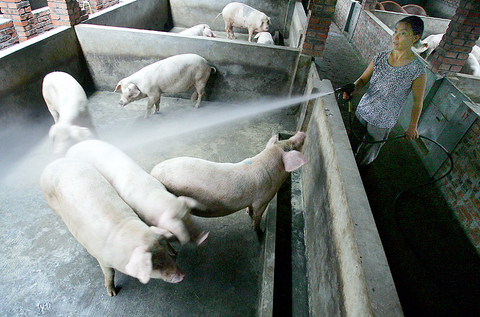A mysterious pig-borne disease has spread to six more towns in southwest China and the number of people killed has risen to 31, the Chinese government said yesterday as it scrambled to reassure the public.
The health ministry said on its Web site that the total number of people affected increased to 152 by noon on Wednesday -- four more deaths and 21 more cases than the day before. Twenty-one people are in critical condition.
Six more towns in Sichuan Province reported cases on Wednesday, in addition to the two cities, Ziyang and Neijiang, where people first fell ill after slaughtering pigs foaming at the mouth last month, the ministry said.

PHOTO: AFP
The World Health Organization (WHO) said it was baffled.
It said if the disease was indeed caused by the streptococcus suis bacterium, as preliminary Chinese results show, it would be the first time the bacterium had struck so many people at one time -- raising fears it had become more virulent.
The Chinese government was working to reassure the public that it had the problem under control, stressing the spread could be stopped if people avoided slaughtering infected pigs.
"We have the technology and procedures to bring the disease under control," the China Daily quoted an agriculture ministry official as saying.
Investigations show that only those who came in contact with infected pigs or pork -- through slaughtering or processing -- and had open wounds fell ill, the Beijing Daily Messenger cited experts as saying.
Those who only ate the cooked pork did not get sick, it said.
The victims were mostly farmers who raised pigs in small, insanitary farms. Farmers said they had a habit of eating sick pigs instead of burying them because they were poor.
Newspaper accounts said many people pitched in to shave the hair off the killed swine, wash the internal organs and chop up the meat to distribute.
One woman who fell ill was quoted by the Beijing Daily Messenger as saying that she did not think anything of the small wound on her hand when she helped a relative kill a pig last week.
"After killing the pig, our entire family boiled three bowls of pork to eat. After eating just a few mouthfuls of the meat, I felt my heart pound, dizzy and nauseous," Jiang Suhua said. "Later my legs were so weak I couldn't stand up. My arms and legs also had large blotches of blood under the skin."
Another farmer said that a relative gave him a slice of freshly cut pork and he became dizzy and weak just from taking the pork home.
Other symptoms include high fever, vomiting and hemorrhaging, with many patients going into severe shock. Some of the victims died within 10 hours of showing symptoms, reports said.
The disease is rare, with the first recorded case in Denmark in 1968. More than 200 cases of human infection have been reported since then, not counting the latest data.
WHO spokesman Bob Dietz said it was too soon to say the bacterium was the cause or the only cause of the outbreak, adding that more laboratory tests were needed to see if other factors may be at work.
"We can't discount the possibility there could be other bacteria, virus or something else active in here," Dietz said.
The bacterium is endemic in Asia, North America and Europe, he said.
If it is the cause of the outbreak, the Chinese farmers' close proximity to their pigs might be a reason for the large number of cases.
"What we're accustomed to seeing is one or two cases ... Here, where pigs and humans are so intertwined in the countryside, it might explain why so many people are becoming sick," Dietz said.
An outbreak occurred in 1998 in eastern Jiangsu Province and a few people died, the China Daily quoted researchers as saying, but they did not reveal a death toll.

The CIA has a message for Chinese government officials worried about their place in Chinese President Xi Jinping’s (習近平) government: Come work with us. The agency released two Mandarin-language videos on social media on Thursday inviting disgruntled officials to contact the CIA. The recruitment videos posted on YouTube and X racked up more than 5 million views combined in their first day. The outreach comes as CIA Director John Ratcliffe has vowed to boost the agency’s use of intelligence from human sources and its focus on China, which has recently targeted US officials with its own espionage operations. The videos are “aimed at

STEADFAST FRIEND: The bills encourage increased Taiwan-US engagement and address China’s distortion of UN Resolution 2758 to isolate Taiwan internationally The Presidential Office yesterday thanked the US House of Representatives for unanimously passing two Taiwan-related bills highlighting its solid support for Taiwan’s democracy and global participation, and for deepening bilateral relations. One of the bills, the Taiwan Assurance Implementation Act, requires the US Department of State to periodically review its guidelines for engagement with Taiwan, and report to the US Congress on the guidelines and plans to lift self-imposed limitations on US-Taiwan engagement. The other bill is the Taiwan International Solidarity Act, which clarifies that UN Resolution 2758 does not address the issue of the representation of Taiwan or its people in

US Indo-Pacific Commander Admiral Samuel Paparo on Friday expressed concern over the rate at which China is diversifying its military exercises, the Financial Times (FT) reported on Saturday. “The rates of change on the depth and breadth of their exercises is the one non-linear effect that I’ve seen in the last year that wakes me up at night or keeps me up at night,” Paparo was quoted by FT as saying while attending the annual Sedona Forum at the McCain Institute in Arizona. Paparo also expressed concern over the speed with which China was expanding its military. While the US

SHIFT: Taiwan’s better-than-expected first-quarter GDP and signs of weakness in the US have driven global capital back to emerging markets, the central bank head said The central bank yesterday blamed market speculation for the steep rise in the local currency, and urged exporters and financial institutions to stay calm and stop panic sell-offs to avoid hurting their own profitability. The nation’s top monetary policymaker said that it would step in, if necessary, to maintain order and stability in the foreign exchange market. The remarks came as the NT dollar yesterday closed up NT$0.919 to NT$30.145 against the US dollar in Taipei trading, after rising as high as NT$29.59 in intraday trading. The local currency has surged 5.85 percent against the greenback over the past two sessions, central